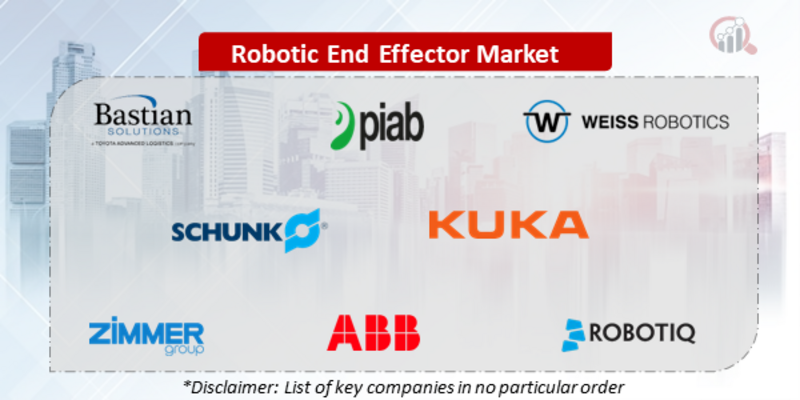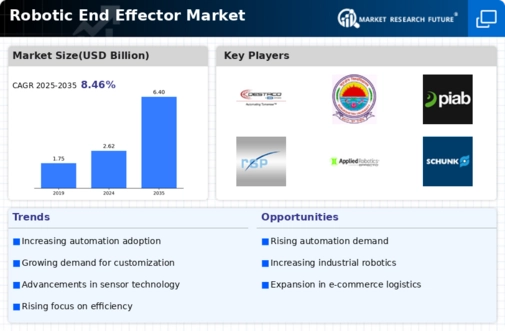Top Industry Leaders in the Robotic End Effector Market

The Competitive Landscape of the Robotic End Effector Market
The robotic end effector market, where robot arms meet the world, pulsates with intricate movements and fierce competition. Understanding the strategies, key players, and future trends is crucial for businesses navigating this dynamic terrain and shaping the dexterity of industrial robots.
Key Player:
- Bastian Solutions, Inc.
- Piab AB
- Weiss Robotics GmbH & Co. KG
- Schunk GmbH
- KUKA Robotics Corporation
- Zimmer Group
- ABB Group
- Robotiq Inc
- DESTACO Europe GmbH
- Schmalz GmbH
Strategies Adopted by Leaders:
- Specialization and Diversification: Leading players like SCHUNK and OnRobot focus on specific types of end effectors (grippers, welding guns, etc.) while expanding their portfolios to cater to diverse applications. ABB Robotics prioritizes customization and adaptability, designing end effectors tailored to their robots' capabilities.
- Focus on Dexterity and Versatility: Delivering precise manipulation and handling capabilities across different object shapes and sizes is paramount. Festo prioritizes multi-functional grippers with adaptable fingers, while Piab specializes in vacuum grippers for delicate object handling.
- Integration with Sensors and AI: Enhancing intelligence and adaptability through sensor integration and AI control allows for autonomous grasping and real-time adjustments. Robotiq partners with NVIDIA to integrate AI vision systems into their grippers, while ATI Industrial Automation focuses on force-sensing grippers for automated tasks.
- Cost-Effectiveness and Scalability: Making end effectors affordable is crucial for wider adoption, especially in cost-sensitive industries. Schmalz prioritizes modular designs and cost-efficient materials, while WEBER Gripping Systems focuses on mass production and economies of scale.
- Focus on Sustainability and Safety: Utilizing eco-friendly materials and prioritizing operator safety demonstrate environmental and social responsibility, resonating with consumers and regulations. Zimmer Group emphasizes sustainable materials and ergonomic designs, while Destaco prioritizes safety features like overload protection and finger guards.
Factors for Market Share Analysis:
- Brand Reputation and Technological Expertise: Established players like SCHUNK and ABB Robotics hold an advantage with proven track records, extensive research and development capabilities, and strong relationships with industrial robot manufacturers. This legacy inspires trust and facilitates adoption in large-scale projects.
- Portfolio Breadth and Specialization: Offering a diverse range of end effectors for various applications caters to different user needs and market segments. OnRobot's extensive portfolio of modular grippers exemplifies this approach, while ATI Industrial Automation's expertise in force-sensing grippers offers a niche advantage.
- Technology Innovation and Integration: Investing in R&D and integrating sensors, AI, and advanced materials keeps companies at the forefront of innovation. Robotiq's AI-powered grippers and Destaco's integrated safety features demonstrate such advancements.
- Manufacturing Capacity and Scalability: Having efficient production facilities and the ability to ramp up production is crucial for meeting growing demand, especially in high-growth markets like Asia. WEBER Gripping Systems' large-scale production capabilities and Schmalz's global manufacturing network offer advantages.
- Focus on Sustainability and Regulatory Compliance: Demonstrating commitment to sustainability initiatives and regulatory compliance resonates with environmentally conscious consumers and responsible manufacturers. Zimmer Group's focus on recyclable materials and Destaco's compliance with safety regulations are noteworthy examples.
New and Emerging Companies:
- Soft Robotics Inc.: Pioneering soft-gripper technology mimicking the dexterity of human hands, enabling safe and delicate handling of fragile objects.
- Festo Corp.: Developing bioinspired end effectors like the Bionic Manipulator, offering adaptive grasping and enhanced dexterity for complex tasks.
- Gripper Systems Inc.: Specializing in customized end effectors for specific industrial applications, providing tailored solutions for unique needs.
- ExoSkeleton Tech LLC: Focusing on exoskeleton-assisted end effectors that augment human capabilities and reduce worker fatigue.
Latest Company Updates:
Bastian Solutions, Inc.:
- October 20, 2023: Bastian Solutions unveils its new line of custom robotic end effectors for automated material handling applications, designed for specific tasks like pallet manipulation, heavy object lifting, and precise product picking
- July 12, 2023: Bastian Solutions partners with a major robotics integrator to develop an innovative hybrid end effector combining vacuum grippers with robotic fingers, offering versatility and adaptability for handling diverse objects
Piab AB:
- October 17, 2023: Piab releases its latest series of high-precision vacuum grippers with integrated sensors and control software, ideal for delicate object handling and automated tasks requiring precise force management
- July 6, 2023: Piab collaborates with a leading food and beverage manufacturer to develop custom end effectors for automated food handling, ensuring hygiene, safety, and product integrity









